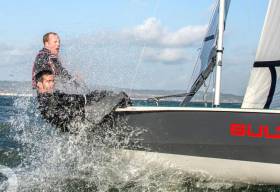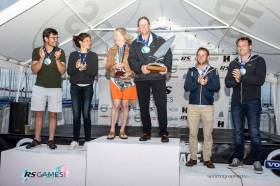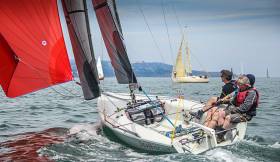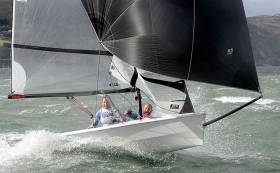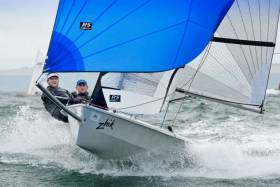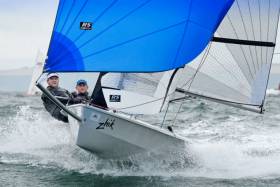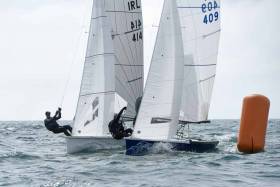Displaying items by tag: RS400
RS400s Hit 24 for Frostie Series at Royal North of Ireland Yacht Club
Sun 18th Nov was the third day of Belfast Lough's RS400 Frostie Series at Royal North of Ireland Yacht Club in what has become the biggest doublehanded fleet in the country winter racing with 22 boats on the water and 3x420s joining the fun as well.
The conditions were ideal with 11-18 knots through the day with an easterly direction incl some 30-degree shifts providing some swell giving epic sailing for these need-for-speed power-hungry boats & sailors to provide close, fast, place-changing sailing.
The first race the fleet were so keen the OOD had no option but to pull back the fleet due to their indiscretions and go with a black flag. The second time they got away in a fresh breeze coming from Scotland providing hiking conditions in gusty/shifty conditions. Dr Bob, Sam Pickering, Paul McL were in the hunt first lap but with big gains to be made on the downwinds other boats came into it making exciting racing. In the end, Dr Bob held on after a late charge last downwind from Barry McCartin and Bosun Bob Hastings to come in 2nd and 3rd.
The second race got away first time and Sam Pickering lead from Dr Bob & Hammy Baker. By the second lap there was still nothing in it among the top 10 and on last downwind McCartin called the last gybe layline just right to come through for the win over Sam and Dr Bob in 2nd/3rd.
The third and final race got away first time again (for the 3rd start according to OOD all boats hitting the line a sight to see) except for an individual recall for the overkeen Dr Bob. Chris Penney lead with Mr D'arcy and numerous others in hot pursuit in strengthening conditions allowing full planing. At the bottom BMcC, CP, D'arcy and Dr Bob making a heroic recovery all lead at various stages but in the end Dr Bob got it for 2nd win of day followed by BMcC and CP. Paul McL still leads the series after some boat trouble today breaking wing-wang in 2 races but for the 3rd stole a boat from an Olympian and even being late came home 11th to keep just ahead of Olly & Tiff and steady-eddies D'arcy & Ginge in 3rd with 1st discard in play. Results below.
It was the best weekend so far racing in superb conditions for all concerned with numerous passers-by on the shore commenting at the sheer number and speeds of the 400s racing only 200 metres from the shore The 4th weekend continues on Sun 23 November with notions of certain members from host club interested in getting a boat to join the fun we could soon be hitting 25 boats!
RS400 'Frostie' Series Kicks off on Belfast Lough
The start of the RS400 winter racing season begins at 2pm on Sunday at the Royal North of Ireland Yacht Club on Belfast Lough. The annual RS400 Frostie Series, has grown over the years and this year the club expects to have over twenty boats lining up on the start line which is great for any double-handed class.
There will be three back to back races every Sunday. The beauty of it is that the races are short sprint style windward leeward’s with only two laps which makes it fun and exciting. The racing will go right up until Sunday 23rd December where the winner will be crowned and presented with the Trophy.
"The annual RS400 Frostie Series, has grown over the years and this year the club expects to have over twenty boats lining up"
Past winners have included Liam Donnelly & Rick McCaig, Trevor D’Arcy & Ginge, Robert Hastings & Rory Higgins and last year Paul McLaughlin and Own McKinley from Cushendall picked up the Bosun Bob’s Trophy.
So who is also in the mix this year? Bob Espey is getting in back in the saddle joined by Richard McCullough. Bob is a past winner of many of the regional events and one to watch. Barry Mac who has been dabbling with Fireballs, is joined up front with Andrew Penny. Chris and Jess Penny have a fairly fresh boat and aim to have the fleet behind them. Tiffany Briens & Oli Loughhead are joining forces this year and they have reportedly been out practicing. Hammy Baker will be back and has a newer boat. Sam Pickering, new to the fleet this year will be joined by Simon Martin. Peter Kennedy & Stevie Kane fresh from winning the “All Ireland Sailing Championships” are hoping to put some manners on the young bucks.
RNIYC will be hosting the UK & Irish RS400 Nationals in August 2019, many crews have this well in their sights so will be using the Frostie Series as good practice. It is expected there will be one more boat purchased before the year is out.
Cork Harbour’s Barry & Leonard Third In RS400 Europeans
#RS400 - Alex Barry and Richard Leonard finished third in the RS400 Europeans at Weymouth this week.
The Cork Harbour duo completed an international podium, with Stewart and Sarah Robertson of Scotland taking the win and Francisco and Teresa Lobato of Portugal in second.
Sailing was very tight throughout the five days of racing for the 71-boat fleet, with Barry reporting that any one of five boats was capable of taking the event in the last race.
Notable entries included double Olympic silver medalist and Volvo Ocean Race winner Ian Walker, who was ninth overall.
Robbie O’Sullivan and Phil McGlade were the other Irish boat traveling, with a 33rd place finish in the Gold fleet. Full results are here.
The event was part of the wider RS anniversary games, which will see 2,000 sailors take to the water at the Weymouth and Portland National Sailing Academy by the end of this month.
Event number two of the 2018 RS season happened over the bank holiday of 5/6 May in Rush Sailing Club, North Co. Dublin to host the Eastern Championships for RS400s/200s/Fevas.
In total there was 30 boats entered with many other in support for the event to sail at the rumoured best kept sailing venue secret on the East coast and very accessible for everyone to get to with lots of space and camping facilities to go with.
Forecasts for the weekend seemed to promise first signs of summer for the country and this was exactly to be the case as by about 12pm a sea breeze started literally rolling in with waves from the South to boot. PRO Richard Kissane sent the fleet out the river for first some tacking practice &then 3 races in the building and fantastic conditions.
"with notable absentee Alex Barry and Richard Leonard the question was who could step up?"
There were many runners and riders for the event but with one notable absentee Alex Barry and Richard Leonard the question was who could step up?
In conditions 15-18knots racing got underway and local legend Alan Ruigrok & Max McKnight stormed away to show the fleet they were in the mood. Gareth Flannigan & David Fletcher pulled in a 2nd with moving up from school in the 200s Neil Spain & Ross McDonald coming in 3rd.
In the second race Alan Ruigrok & Max McKnight lead again but Neil Spain & Ross McDonald got them downwind to take win with Barry McCartin & Andrew Penney 3rd. The final race Alan Ruigrok & Max McKnight blitzed away again to take bullet, Gareth Flannigan & David Fletcher 2nd & Neil Spain & Ross McDonald 3rd. Racing among the boats was so tight with many photo finishes required throughout the 3 races and the big waves taking a few victims as they fell in downwind.
In the 200s Cian Jones & Luke McGrath revelled in conditions for 3 bullets. Aaron Jones & Katie Kane not far away with 3 2nds and Ben Ferris & Peter Darragh completing the over night top 3. In the Fevas Lily Thorup & Sibeal Nic Giolla Coda dominated with 3 firsts - followed by Matthew McClernon & Erin McClernon with an equally consistent 3 2nd places and Alannah McGuire & Rachel Keane completing the over night top 3.
Everyone retreated ashore in awe of a great day sailing and first pints were flowing by 4pm to make things even better. The club staged a great BBQ, bar and band to keep everyone entertained.
Day 2 lead to a slight postponement as some fog came in before fleet were sent out in a building 11-14 knot breeze. More tacking practice out the harbour and soon enough course was laid and races began. In the first race the racing was super close with only 1min separating the top 10 by finish but Gareth Flannigan & David Fletcher won squeezing Alan Ruigrok & Max McKnight into 2nd, Neil Spain & Ross McDonald 3rd. The 2nd race wind picked up slightly again giving more surfing conditions. This time Alan Ruigrok & Max McKnight won after a very tight battle with Paul Mclaughlin & Owen McKinley with Barry McCartin & Andrew Penney in 3rd. This secured the event for Alan Ruigrok & Max McKnight but places behind were all to play for especially given retirement due to unfortunate toe-strap break on Gareth Flannigan & David Fletcher's boat sending them home early.
This time Paul Mclaughlin & Owen McKinley sailed a great race only for Alan Ruigrok & Max McKnight (sailing on anyway) to come from way back as the wind got light and patchy to steal it at the death. Neil Spain & Ross McDonald came in 3rd. This made the final results as follows: Alan Ruigrok & Max McKnigh in 1st with a near flawless scoreline, Neil Spain & Ross McDonald 2nd, Paul McLaughlin & Owen Mckinley in 3rd, Barry McCartin & Andrew Penney 4th &and Gareth Flanagan & David Fletcher in 5th.
The 200s had closer racing as few more boats get in the mix including another Ruigrok Erica Ruigrok & Lauren O'Hare to mix in the top 3 - standing head and shoulders above... her crew with very well practised capsize technique. But in the end Cian Jones & Luke McGrath added 3 more wins to make a perfect scorecard and win Boat of the weekend followed by Aaron Jones & Katie Kane in 2nd & Ben Ferris & Peter Darragh 3rd.
In the Fevas, Alannah McGuire & Rachel Keane upset the pecking order with a win in the first race of the day. Matthew McClernon & Erin McClernon secured the top spot in the next 2 races giving them the series overall relegating the dominant Lily Thorup & Sibeal Nic Giolla Coda to second overall.
A great credit to PRO Richard Kissane and Race Committee who ran the races like clockwork both days setting perfect courses with his mark-team to keep to the schedule and get in 6 races over the weekend. Also to all the organisers, shore teams, canteen personnel and BBQ legends and of course the bar personnel keeping the fleet well oiled long into the night.
And to answer rumour at the top of report, after such an amazing weekend all round, the entire fleet would agree Rush as one of best venues for sailing, hospitality, great craic and one that everyone will talk about for a long time.
The next event is the RS National Championships on 6-8 July, being hosted by Ballyholme YC in conjunction with the Bangor Town regatta for big boats to make it even larger still.
Entry is Open with a lot of planning in place by a club who are well know at running big events and last time they hosted RS championships there was 50 RS400s on startline so let's hope for even more still so certainly not to be missed!
RS400
1st Alan Ruigrok & Max McKnight
2nd Neil Spain & Ross McDonald
3rd Paul Mclaughlin & Owen McKinley
RS200
1st Cian Jones & Luke McGrath
2nd Aaron Jones & Katie Kane
3rd Ben Ferris & Peter Darragh
Feva
1st Matthew McClernon & Erin McClernon
2nd Lily Thorup & Sibeal Nic Giolla Coda
3rd Alannah McGuire & Rachel Keane
Irish National Sailing Club's 'Super Series' Adds SB20s to Dun Laoghaire Winter Series
The Irish National Sailing Club Super Series is expanding this year and as well as racing for RS200/400s, the Dun Laoghaire Harbour based winter series will also include racing for SB20 sportsboats.
With a 10am first gun, the aim is to do as many sprint style racing races as possible (max 5) and off the water by 1pm.
The schedule will be five race Saturdays over the winter from November 11th. And then on December 16th, January 13th, February 10th and March 10th.
There will be simple windward–leeward courses with a leeward gate and spreader at top with a start/finish line at the bottom of the beat.
The cost is €50 to enter the series per boat either SB20 or RS200/400.
Check out the 2016/17 RS Super Series video below for a flavour of the action...
Enter here
RS400s & RS200s In Action at Greystones Sailing Club
The RS400 and RS200 fleets gathered at Greystones Sailing Club in County Wicklow last weekend for their National and Southern Championships respectively writes David Rose.
The Irish RS fleets, like Greystones harbour itself, have continued to evolve and renew with the times. Both are in rude health. Some of the first RS400’s in Ireland sailed here and the club honour board has a dedicated section to the GSC members who have been club and national champions of the past. Son of GSC Sean Cleary won the southern championship event the last time the RS400 show was in town, and his family were involved again this year, with Conor Clery pairing up with Katie Noonan in a 400. Sean still sails a RS400 in the UK where he has settled, hopefully just for now. The RS400 has been a national fleet for a few years now, with strongholds in Cork, Northern Ireland, Dublin Bay and many other locations including GSC. 2017 has been a strong year and 30 of the best boats on the island descended on the town well prepared for the national championship battle.
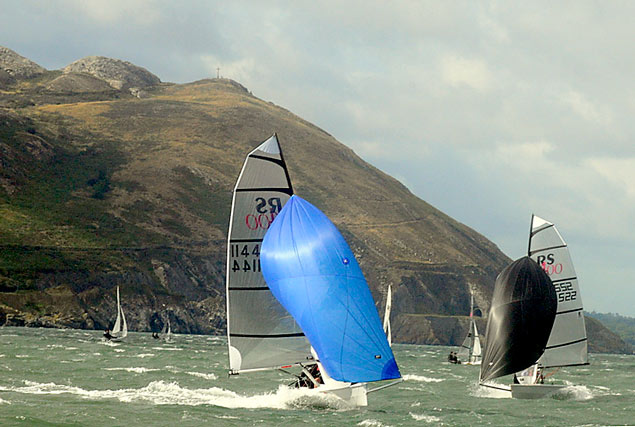 Full speed under Bray Head for RS400 dinghies on the Greystones Sailing Club race track. Photo: Alan Leddy
Full speed under Bray Head for RS400 dinghies on the Greystones Sailing Club race track. Photo: Alan Leddy
Tom Rusbridge, our race officer, who flew in from West Sussex for the event and his team provided great courses and went about their job with minimum delays between races and notably few recalls required. They really did not put a foot wrong in difficult conditions, including 70 degree wind shifts in races two and four of the 400 event. Saturday was very exciting and the wind added to the tidal theatre with gusts regularly over 30knots. Legend has it that one yacht clocked 38 knots, but we only have picture evidence of 33 knots from the committee boat. The committee looked as though they were competing hard with the conditions themselves. The final day of our events had to be called off due to a very grim forecast. The PRO felt that it was not worth risking people’s safety and the majority of competitors agreed. These are high performance dinghies and while they are wonderful fun in breeze, they do provide a challenge to rescue cover and crews on very windy days. The event was to provide plenty of drama, with massive wind shifts on day one and a tidal race that caught more than a few people out on lay lines and rounding’s. The locals explaining shore side that the tide generally goes south here, unlike everywhere else on the east coast where the tide will go out to the south and in the north.
Gareth Flannigan and David Fletcher arrived battle hardened from the recent Laser Masters event in which Gareth took gold and David a very respectable 7th. The team have always competed for RS silverware and this event was no different, with a superb opening day carding a 3, 1, 3, 2, putting them in second overnight by a point to Alex Barry and Grattan Roberts who also had one bullet day one but followed it up with two seconds. Our welcome English visitors Jon Willars and Richard Brameld having won the opening race lay in third also carding two 4ths. David Rose and Ian Hef had won race three, but were off the pace in the other races and lay in 7th overnight. Locals Peter Bayly and Paddy Blackley had carded a very solid 6, 3, 11, 6 and were sitting in 5th behind Emmet and James Ryan from RstGYC. John Downey and Sandy Rimmington had an unspectacular day but remained in contention with a 5, 5, 7, 7.
Grattan Roberts was drafted in by Alex Barry for this year’s RS400 nationals, and he had very big boots to fill. Some sports people just thrive in situations like that, and at 19 Grattan has very little to prove having already won the National 18 National championships with Charles Dwyer in Cork this year. Grattan’s father of the same name is a cork sailing legend was the helm of the swan 65 Desperado. Grattan sails everything going, having grown up with the 420 academy scene. Last year he sailed the RS400 with Johnny Durcan carding a 5th place overall. He is a regular 1720 sailor and often sails on Cork’s Anchor Challenge in the Quarter Ton Scene. Grattan is an Irish sailor who we can expect to be reading about for many years to come.
John Downey and Sandy Rimmington approached the windy Saturday with a swagger that was lacking in much of the fleet. Sporting these new Rasher Rasher’s, they proved sublime on the day carding all results lower than day one. Their impressive 3,1,3,1 results had them breathing down the neck of Gareth Flannigan and David Fletcher who took second overall on 21 points to John and Sandy’s 25. Gareth and David have always been superb in the breeze and they carded 10, 4, 4, 4 which was solid on a day where most struggled. So to our national champions, Alex Barry and Grattan Roberts, who continued on day two where they left off on day one with an absolutely dominant 1,2,1,2. That was making it three bullets and three seconds in the series to card a stunning 11 points and overall victory. Alex and Grattan had a habit of recovering quickly whenever they found themselves in the pack, a sign of great champions. This is officially Alex’s second RS400 title, having been best Irish boat once before also and recorded a second another year. So Alex is 1, 2, 2, 1 for national titles since joining the class, and has firmly established himself as legend.
A special thank you to Australians Paul and Bronwyn Ridgeway from Melbourne who made it to the northern hemisphere just to race RS400’s and to our English visitors Jon Willars and Richard Brameld who were fifth and Ben Williamson and Ed Wheldon who were tenth.
The RS200 Class has had a fantastic year, and the fleet numbers are up in almost every event. They had their national championships in Cork earlier in the season, where the fleet has taken hold. As I mentioned earlier the second day of the event had to be called off due to a very bad forecast, however the fleet competed hard for honours on Saturday and there was something of a passing of the baton from Marty O’ Leary and Rachel Williamson bowing out of the class gracefully out of the results. They have been a very dominant pair over the last few years and no doubt will be missed. Frank and son Kevin O’Rourke sailing out of their native GSC stepped up and dominated with a whitewash. Followed by RCYC’s Katie and brother Jamie Tingle who recorded a 2, 4, 2. RCYC took third also with Cian Jones and Jonathan Sargeant. There were 18 200’s and lots of new faces, the future is very bright for this class.
Download results below.
Fourth For Barry & Leonard At RS400 UK Nationals
#RS400 - A solid fifth in the final race of the RS400 UK Nationals yesterday (Thursday 24 August) capped off a week that saw Alex Barry and Richard Leonard finish fourth overall.
The ultimate result was even more satisfying for the Royal Cork/Monkstown Bay pair as they were among the few boats to get ahead of potentially race-stopping sea breeze, one that opened a sizeable hole in the course on Mount’s Bay and left most of the fleet in confusion, as Yachts and Yachting reports.
It was also much consolation after a disappointing first race on the day — Barry and Leonard’s worst placing of the week at 29th but one that discards ensured wouldn’t blemish their final tally.
As predicted, John Gorringe and Oli Wells of Parkstone Yacht Club took the championship with a bullet in the very last race of the five-day event, though it wasn’t a sure thing after a seventh in Thursday’s first race took a chunk out of their lead and added to the pressure.
Meanwhile, three other Irish boats in the fleet showed strong performances in Cornwall this week.
Monkstown Bay’s John Downey and Sandy Rimmington were the highest placed Bronze fleet pairing at 11th overall, while Sean Cleary and Annalise Nixon of Oxford Sailing Club placed 24th and Robbie O’Sullivan and Phil McGlade, also of Monkstown Bay, finished 38th.
Cork Harbour Duo Barry & Leonard Going Strong At RS400 UK Nationals
#RS400 - It’s fifth place for Alex Barry and Richard Leonard after three days and six races at the RS400 UK Nationals in Cornwall.
The recent Southern Championship defending pair from the RCYC and Monkstown Bay on Cork Harbour scored a fourth and an 11th in racing on Mount’s Bay today (Wednesday 23 August), making their lighter set-up work despite the breeze.
Though the results saw them drop down a couple of places on the overall table, Barry and Leonard remain within touching distance of the championship currently within the grasp of John Gorringe and Oli Wells of Parkstone Yacht Club in Poole, who scored a pair of bullets to extend their lead.
RS200, RS400 & RS Feva Fleets Gather at Blessington Sailing Club for Inland Championships
Over RS Sailing 40 crews arrived at Blessington Sailing Club to the clubs usual very friendly hospitality to join the newly established local fleet of RS200’s writes Kevin Brazel. Download full results below.
With a 1300 first gun on Saturday morning and a forecast for dying breeze, race officer Robin Gray from Ballyholme was eager to get things off in his ever efficient way.
The standard windward leeward course with a gate was set in a typical shifty lake breeze. The RS400 fleet was sent off first but a major shift before the first top mark caused the race to be abandoned. At the second time of asking, Trevor D’Arcy and crew Alan McLemon came out on top in Race one.
A testament to the tight racing enjoyed by the RS400 fleet was the fact that there was a different winner in each race. Rob Hastings and crew Lawrence from the Royal North took race two. Monkstown’s Robbie O’Sullivan and Phil McFountain won race three. With the most consistent top results and a win in race 4 Paul McMahon & Simon Martin from Howth took the title of RS400 2017 inland champions
In the RS200 fleet Marty O’Leary and Rachel Williamson showed more of the speed they’ve had all season. The only blot on a their score card was an OCS in race 4 when Marty was a little premature, much to the annoyance of Rachel. Emmet Ryan and Kevin Brazel, who were making the change in “weight division” to the 200 for the weekend took second place with Greystone’s Frank O’Rourke with Diana Kissane in third.
The youth class, the RS Feva turned out to be a very competitive fleet, with the winner, Royal St. George’s Marcus O’Leary showing consistency is key. Not winning a race but being always in the front 3 to take the overall win. Second was Max and Georgia Goodbody from the Royal Irish, and third was Alan Leddy crewed by Greg Houlihan from Greystones.
Once on shore the Blessington members put on a great show, with a michelin-star barbeque on the beach, cheap beer and music until late to keep the many sailors staying around the club entertained, the best apres-sail anyone in the fleet can remember of the last few years!
Thanks to Blessington for running an absolutely brilliant event, with incredible food and real hospitality. Big thanks to Robin for doing a perfect job on the committee boat, managing to get four races off in very difficult conditions.
Next up are the RS400 Nationals and RS200 Southerns in Greystones on the 8th ,9th and 10th of September.
No sooner has Howth Yacht Club completed its Spring Warmer Series for keelboats than it is preparing for its first dinghy event of the 2017 Summer season. HYC will host the RS Eastern Championship over the 22nd April and 23rd April.
The RS classes will be joined by Cork Harbour's travelling National 18s and the SB20 sportsboat class.
In the run up to the championships, the RS Feva class are staging a two day training session in Howth. Training is open to all sailors around the country regardless of ability. 20 boats are expected for the Easterns and there is a lot of renewed interest in the class now from Optimist sailors looking to try a two hander.
An early bird entry discount has been extended until tomorrow (April 12), according to HYC's Ross MacDonald. Enter here.



























